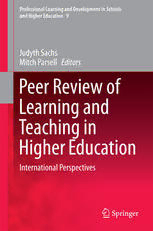
Peer Review of Learning and Teaching in Higher Education: International Perspectives PDF
Preview Peer Review of Learning and Teaching in Higher Education: International Perspectives
Peer Review of Learning and Teaching in Higher Education Professional Learning and Development in Schools and Higher Education SeriesEditors ChristopherDay JudythSachs ProfessionalLearningandDevelopmentinSchoolsandHigherEducationdissemi- natesoriginal,researchinformedwritingontheconnectionsbetweenteacherlearning andprofessionalisminschoolsandhighereducation. Globalintheircoverage, the texts deal with the problems and practices of the field in different national and internationalcultural,policyandpracticecontexts.Themethodologyemployeden- compassesabroadspectrumofconceptual,theoretical,philosophicalandempirical researchactivities.Theseriesexplicitlyencompassesboththefieldsofschoolsand highereducation. Thesubjectareascoveredbytheseriesare:professionallearninginschools;con- texts for professional learning; professional learning in higher education; change; the(new)meaningsofprofessionalisminschoolsandhighereducation;trainingand developmentinschoolsandhighereducation;the‘well-being’agendainschoolsand highereducation;autonomy,complianceandeffectivenessinschoolsandhigheredu- cation;principalleadershipinschoolsandhighereducation;middle-levelleadership inschoolsandhighereducation. Forfurthervolumes: http://www.springer.com/series/7908 Judyth Sachs • Mitch Parsell Editors Peer Review of Learning and Teaching in Higher Education International Perspectives 2123 Editors JudythSachs MitchParsell MacquarieUniversity FacultyofHumanSciences Sydney MacquarieUniversity NewSouthWales Sydney Australia NewSouthWales Australia SupportfortheproductionofthispublicationhasbeenprovidedbytheAustralianGovernment OfficeforLearningandTeaching.Theviewsexpressedinthispublicationdonotnecessarily reflecttheviewsoftheAustralianGovernmentOfficeforLearningandTeaching. ISBN978-94-007-7638-8 ISBN978-94-007-7639-5(eBook) DOI10.1007/978-94-007-7639-5 SpringerDordrechtHeidelbergLondonNewYork LibraryofCongressControlNumber:2013951529 © SpringerScience+BusinessMediaDordrecht2014 Thisworkissubjecttocopyright.AllrightsarereservedbythePublisher,whetherthewholeorpartofthe materialisconcerned,specificallytherightsoftranslation,reprinting,reuseofillustrations,recitation, broadcasting,reproductiononmicrofilmsorinanyotherphysicalway,andtransmissionorinformation storageandretrieval,electronicadaptation,computersoftware,orbysimilarordissimilarmethodology nowknownorhereafterdeveloped.Exemptedfromthislegalreservationarebriefexcerptsinconnection withreviewsorscholarlyanalysisormaterialsuppliedspecificallyforthepurposeofbeingenteredand executed on a computer system, for exclusive use by the purchaser of the work. Duplication of this publicationorpartsthereofispermittedonlyundertheprovisionsoftheCopyrightLawofthePublisher’s location,initscurrentversion,andpermissionforusemustalwaysbeobtainedfromSpringer.Permissions forusemaybeobtainedthroughRightsLinkattheCopyrightClearanceCenter.Violationsareliableto prosecutionundertherespectiveCopyrightLaw. Theuseofgeneraldescriptivenames,registerednames,trademarks,servicemarks,etc.inthispublication doesnotimply,evenintheabsenceofaspecificstatement,thatsuchnamesareexemptfromtherelevant protectivelawsandregulationsandthereforefreeforgeneraluse. Whiletheadviceandinformationinthisbookarebelievedtobetrueandaccurateatthedateofpublication, neithertheauthorsnortheeditorsnorthepublishercanacceptanylegalresponsibilityforanyerrorsor omissionsthatmaybemade.Thepublishermakesnowarranty,expressorimplied,withrespecttothe materialcontainedherein. Printedonacid-freepaper SpringerispartofSpringerScience+BusinessMedia(www.springer.com) Preface TheprojectandthisvolumehavebenefittedfromtheincredibleleadershipofPro- fessorJudythSachs,DeputyViceChancellorandProvostatMacquarieUniversity. Professor Sachs is a champion of learning and teaching, collegial development andthescholarshipofteaching.Thesethreethemescometogetherinthisvolume. Through luck and persistence the volume has managed to attract contributions for someofthethoughtleadersintheseareas,includingDavidGoslingandMickHealey forEurope;AmyGoodburnandWilliamBuskistfromNorthAmerica;WendyKilfoil fromSouthAfrica;and,MaureenBellandDavidSpencerfromAustralia. Each contributor brings a unique set of skills and vastly different perspectives to the volume. But all agree that collegial review could be a powerful force for improvingteachingandtherebystudentlearning.Yetformanylecturersthethought ofhavinganotherpersonreviewtheirteachingisconfronting.Clearlyitisnotreview persethatistheproblem.Theacademyisbuiltonpeerreview.Wesubmitjournal articlesinthefullknowledgethatsomeoneisgoingtoreadthemanddecidewhether theyareworthpublishingornot.Weroutinelyaskforcolleaguestocommentondraft papersinthehopeofmakingthembetter,ofimprovingtheirquality.Butreviewof teachingisanothermatter.Thereareanumberofreasonsforthis.Acommonlycited reasonisanonymity.Peerreviewofresearchisanonymous;peerreviewofteaching is not. But notice this only applies to the blind review used by journals. It would beprettyatypicaltohaveanonymousdevelopmentalreviewinresearch.Thatform of review is between colleagues. A second obvious difference is between what is being reviewed. Review of research is a review of a product; review of teaching is a review of performance. Performance is much closer to the person. Review of theproductdoesnotinvolvepeoplelookingatyou.Thisdistancebetweenyouand both the reviewer and the focus of review makes it feel less threatening; makes the reviewed feel less vulnerable. But this only applies if teaching performance is beingreviewed.Reviewofteachingartefacts(assessmenttasks,unitoutline,online learningactivities)isthereviewofproducts.Athirddifferenceishowconfidentwe areineachdomain.Mostactiveresearcherswouldconsiderthemselvesreasonably expertwithintheirresearchfield.Thisisnotnecessarilythecasewhenitcomesto teaching.Soyourecogniseyourselfasanexpertinresearch,butyoumaynotfeelan expertinteaching.Butyoushouldwanttobecomeanexpertinteachingoratthevery v vi Preface leastbecommittedtoimprovingyourteaching.Themodelsofpeerreviewpresented inthisvolumeareaimedatallowingyoutodojustthat:improveyourteaching.The volumeisfocusedonimprovingthequalityofteaching.Itisnotcentrallyconcerned withtheassuranceofthequalityofteaching. Linking peer review too closely to quality assurance can lead to negative per- ception about peer review. It may lead to the perception that peer review is about surveillance, an attempt by management to control and monitor staff. Combating thisperceptionisimportantifyouwantbroaduptakeofpeerreviewBroaduptake fromeducatorsdemandsamodelofpeerreviewbasedonthedevelopmentofstaff, notthemonitoringofstaffbymanagement.Itrequiresthatpeerreviewisplacedin acultureofmutualrespect,notacultureofmanagerialcontrol.Thecultureneedsto beanopenoneinwhichwe’repreparedtotalkaboutourteaching,inwhichweare proudtoshareourteachinghighsbutequallyunafraidtoshareourteachinglowsin thehopeofmakingusallbetterteachers. Thepointistomakepeerreviewaboutachievementthroughunity.It’saboutall comingtogetherinanattempttomakeusallbetterteachersbecausewecareabout ourstudentsandwecareaboutourtheirlearningoutcomes. Ultimatelywewantthisvolumetoimprovestudent-learningoutcomes.Wewant it to make us better teachers; better institutional leaders; better developers of our peers so that all of our students have a better learning experience and learn more effectively. StLucia MitchParsell June2013 Acknowledgements Thisvolumehasbenefittedgreatlyfromourdailyinteractionswithourcolleagues onissuesrelatedtolearningandteaching,attendeesattheInternationalSymposium onPeerReview(MacquarieUniversity,2011)andthesupportofLund,Pretoria,La TrobeandMacquarieUniversities.Thankstoall. Thank you to our contributors who have worked both enthusiastically and tire- lessly.Theircontributionsaretestamenttothevarietyofwaysonecansuccessfully andsustainablysupportthedevelopmentofourselvesaseducators. Stef Savanah has provided a great deal of editorial and administrative support duringthefinalstagesofthisvolume.Thisisgreatlyappreciated. ThankstotheAustralianLearningandTeachingCouncilwhofundedsomeofthe researchthatisfoundationaltothevolume;toTheOfficeforLearningandTeaching fortheircontinuedsupportofhighereducationinAustralia;andaspecialthanksto SiobhanLenihanforherunfailingsupport,optimismandenthusiasm. Finally, thanks to our project team members and co-investigators: Steve Cas- sidy,JudiHomewood,LeighWood,LisaWynn,MarcoAmati,AyseBilgin,Melanie Bishop,KelsieDadd,PieterFourie,VerityGreenwood,IanJamie,RobynMoloney, Rahat Munir, Kerry-Ann O’Sullivan, Max Tani, Greg Walkerden and Theresa Winchester-Seeto. vii Contents 1 Introduction:ThePlaceofPeerReviewinLearningandTeaching ... 1 JudythSachsandMitchParsell PartI Theory 2 CollaborativePeer-SupportedReviewofTeaching ................. 13 DavidGosling 3 APracticalModelforConductingHelpfulPeerReviewofTeaching.. 33 WilliamBuskist,EmadA.IsmailandJamesE.Groccia 4 Leadership:ACulturalPerspectiveonReviewasQualityAssurance VersusQualityEnhancement .................................... 53 JeminaNapier,MehdiRiaziandChristaJacenyik-Trawoger 5 ClimatesofCommunication:Collegiality,Affect,SpacesandAttitudes inPeerReview................................................. 67 TrudyAmbler,MeenaChavan,JenniferClarkeandNicoleMatthews 6 SixQuestions .................................................. 85 MichaelHitchens PartII Practice 7 PeerReviewasQualityAssurance ............................... 105 WendyR.Kilfoil 8 PeerReviewforDistanceEducators:TwoCaseStudies............. 125 AndrelynC.Applebee 9 PeerReviewinaFoundationsinLearningandTeachingProgram ... 137 MarinaHarveyandIanSolomonides ix x Contents 10 ImplementingDepartmentalPeerObservationofTeaching inUniversities ................................................. 151 MaureenBellandPaulCooper 11 PeerReviewofTeachingattheUniversityofNebraska-Lincoln ..... 165 AmyGoodburn PartIII Conclusion 12 Was Moses Peer Observed? The Ten Commandments of Peer ObservationofTeaching ........................................ 183 DavidSpencer 13 InternationalPerspectivesonPeerReviewasQualityEnhancement 201 MickHealey,TrudyAmbler,MalinIrhammar,WendyKilfoil andJudithLyons
